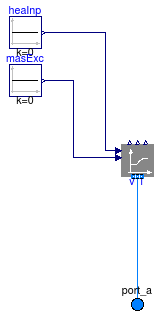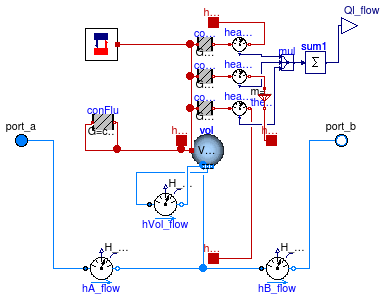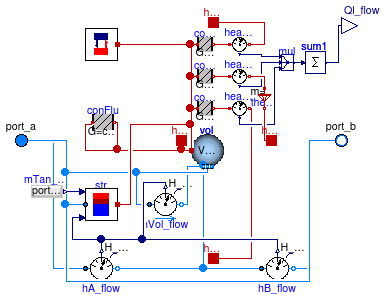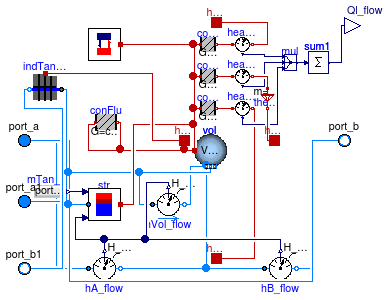

| Name | Description |
|---|---|
| Pressure expansion vessel with fixed gas cushion | |
| Model of a stratified tank for thermal energy storage | |
| Stratified tank model with enhanced discretization | |
| A model of a water storage tank with a secondary loop and intenral heat exchanger | |
| Collection of models that illustrate model use and test models | |
| Package with base classes for Buildings.Fluid.Storage |
 Buildings.Fluid.Storage.ExpansionVessel
Buildings.Fluid.Storage.ExpansionVessel
This is a model of a pressure expansion vessel. The vessel has a fixed total volume.
A fraction of the volume is occupied by a fixed mass of gas, and the other fraction is occupied
by the liquid that flows through the port.
The pressure p in the vessel is
VGas0 * p_start = (VTot-VLiquid) * p
where VGas0 is the initial volume occupied by the gas,
p_start is the initial pressure,
VTot is the total volume of the vessel and
VLiquid is the amount of liquid in the vessel.
Optionally, a heat port can be activated by setting use_HeatTransfer=true.
This heat port connects directly to the liquid. The gas does not participate in the energy
balance.
The expansion vessel needs to be used in closed loops that contain water to set a reference pressure and, for liquids where the density is modeled as a function of temperature, to allow for the thermal expansion of the liquid.
Note that alternatively, the model Buildings.Fluid.Sources.FixedBoundary may be used to set a reference pressure. The main difference between these two models is that in this model, there is an energy and mass balance for the volume. In contrast, for Buildings.Fluid.Sources.FixedBoundary, any mass flow rate that flows out of the model will be at a user-specified temperature. Therefore, Buildings.Fluid.Sources.FixedBoundary leads to smaller systems of equations, which may result in faster simulation.
Extends from Buildings.Fluid.Interfaces.LumpedVolumeDeclarations (Declarations for lumped volumes).
| Type | Name | Default | Description |
|---|---|---|---|
| replaceable package Medium | PartialMedium | Medium in the component | |
| Volume | VTot | Total volume of vessel (water and gas side) [m3] | |
| Volume | VGas0 | VTot/2 | Initial volume of gas [m3] |
| Pressure | pMax | 5E5 | Maximum pressure before simulation stops with an error [Pa] |
| Dynamics | |||
| Equations | |||
| Dynamics | energyDynamics | Modelica.Fluid.Types.Dynamic... | Formulation of energy balance |
| Dynamics | massDynamics | energyDynamics | Formulation of mass balance |
| Initialization | |||
| AbsolutePressure | p_start | Medium.p_default | Start value of pressure [Pa] |
| Temperature | T_start | Medium.T_default | Start value of temperature [K] |
| MassFraction | X_start[Medium.nX] | Medium.X_default | Start value of mass fractions m_i/m [kg/kg] |
| ExtraProperty | C_start[Medium.nC] | fill(0, Medium.nC) | Start value of trace substances |
| ExtraProperty | C_nominal[Medium.nC] | fill(1E-2, Medium.nC) | Nominal value of trace substances. (Set to typical order of magnitude.) |
| Type | Name | Description |
|---|---|---|
| FluidPort_a | port_a | Fluid port |
model ExpansionVessel
"Pressure expansion vessel with fixed gas cushion"
extends Buildings.Fluid.Interfaces.LumpedVolumeDeclarations;
parameter Modelica.SIunits.Volume VTot
"Total volume of vessel (water and gas side)";
parameter Modelica.SIunits.Volume VGas0 = VTot/2 "Initial volume of gas";
//////////////////////////////////////////////////////////////
Modelica.Fluid.Interfaces.FluidPort_a port_a(
redeclare package Medium = Medium) "Fluid port";
parameter Modelica.SIunits.Pressure pMax = 5E5
"Maximum pressure before simulation stops with an error";
Modelica.SIunits.Volume VLiq "Volume of liquid in the vessel";
// We set m(start=(VTot-VGas0)*1000, stateSelect=StateSelect.always)
// since the mass accumulated in the volume should be a state.
// This often leads to smaller systems of equations.
protected
Buildings.Fluid.Interfaces.ConservationEquation vol(
redeclare final package Medium = Medium,
m(start=(VTot-VGas0)*1000, stateSelect=StateSelect.always),
final nPorts=1,
final energyDynamics=energyDynamics,
final massDynamics=massDynamics,
final p_start=p_start,
final T_start=T_start,
final X_start=X_start,
final C_start=C_start,
final C_nominal=C_nominal,
final fluidVolume = VLiq)
"Model for mass and energy balance of water in expansion vessel";
Modelica.Blocks.Sources.Constant heaInp(final k=0)
"Block to set heat input into volume";
Modelica.Blocks.Sources.Constant masExc(final k=0)
"Block to set mass exchange in volume";
equation
assert(port_a.p < pMax, "Pressure exceeds maximum pressure.\n" +
"You may need to increase VTot of the ExpansionVessel.");
// Water content and pressure
port_a.p * (VTot-VLiq) = p_start * VGas0;
connect(heaInp.y, vol.Q_flow);
connect(port_a, vol.ports[1]);
connect(masExc.y, vol.mWat_flow);
end ExpansionVessel;
 Buildings.Fluid.Storage.Stratified
Buildings.Fluid.Storage.Stratified
This is a model of a stratified storage tank.
The tank uses several volumes to model the stratification.
Heat conduction is modeled between the volumes through the fluid,
and between the volumes and the ambient.
The port heaPorVol may be used to connect a temperature sensor
that measures the fluid temperature of an individual volume. It may also
be used to add heat to individual volumes.
The tank has nSeg fluid volumes. The top volume has the index 1.
Thus, to add a heating element to the bottom element, connect a heat input to
heaPorVol[nSeg].
The heat ports outside the tank insulation can be
used to specify an ambient temperature.
Leave these ports unconnected to force adiabatic boundary conditions.
Note, however, that all heat conduction elements through the tank wall (but not the top and bottom) are connected to the
heat port heaPorSid. Thus, not connecting
heaPorSid means an adiabatic boundary condition in the sense
that heaPorSid.Q_flow = 0. This, however, still allows heat to flow
through the tank walls, modelled by conWal, from one fluid volume
to another one.
For a model with enhanced stratification, use Buildings.Fluid.Storage.StratifiedEnhanced.
Extends from Buildings.Fluid.Interfaces.PartialTwoPortInterface (Partial model transporting fluid between two ports without storing mass or energy).
| Type | Name | Default | Description |
|---|---|---|---|
| replaceable package Medium | PartialMedium | Medium in the component | |
| Volume | VTan | Tank volume [m3] | |
| Length | hTan | Height of tank (without insulation) [m] | |
| Length | dIns | Thickness of insulation [m] | |
| ThermalConductivity | kIns | 0.04 | Specific heat conductivity of insulation [W/(m.K)] |
| Integer | nSeg | 2 | Number of volume segments |
| Time | tau | 1 | Time constant for mixing due to temperature inversion [s] |
| Nominal condition | |||
| MassFlowRate | m_flow_nominal | Nominal mass flow rate [kg/s] | |
| Initialization | |||
| MassFlowRate | m_flow.start | 0 | Mass flow rate from port_a to port_b (m_flow > 0 is design flow direction) [kg/s] |
| Pressure | dp.start | 0 | Pressure difference between port_a and port_b [Pa] |
| Assumptions | |||
| Boolean | allowFlowReversal | system.allowFlowReversal | = true to allow flow reversal, false restricts to design direction (port_a -> port_b) |
| Advanced | |||
| MassFlowRate | m_flow_small | 1E-4*abs(m_flow_nominal) | Small mass flow rate for regularization of zero flow [kg/s] |
| Boolean | homotopyInitialization | true | = true, use homotopy method |
| Diagnostics | |||
| Boolean | show_T | false | = true, if actual temperature at port is computed |
| Dynamics | |||
| Equations | |||
| Dynamics | energyDynamics | system.energyDynamics | Formulation of energy balance |
| Dynamics | massDynamics | energyDynamics | Formulation of mass balance |
| Initialization | |||
| AbsolutePressure | p_start | Medium.p_default | Start value of pressure [Pa] |
| Temperature | T_start | Medium.T_default | Start value of temperature [K] |
| MassFraction | X_start[Medium.nX] | Medium.X_default | Start value of mass fractions m_i/m [kg/kg] |
| ExtraProperty | C_start[Medium.nC] | fill(0, Medium.nC) | Start value of trace substances |
| Type | Name | Description |
|---|---|---|
| FluidPort_a | port_a | Fluid connector a (positive design flow direction is from port_a to port_b) |
| FluidPort_b | port_b | Fluid connector b (positive design flow direction is from port_a to port_b) |
| replaceable package Medium | ||
| HeatPort_a | heaPorVol[nSeg] | Heat port of fluid volumes |
| HeatPort_a | heaPorSid | Heat port tank side (outside insulation) |
| HeatPort_a | heaPorTop | Heat port tank top (outside insulation) |
| HeatPort_a | heaPorBot | Heat port tank bottom (outside insulation). Leave unconnected for adiabatic condition |
| output RealOutput | Ql_flow | Heat loss of tank (positive if heat flows from tank to ambient) |
model Stratified
"Model of a stratified tank for thermal energy storage"
extends Buildings.Fluid.Interfaces.PartialTwoPortInterface(
showDesignFlowDirection=false);
replaceable package Medium =
Modelica.Media.Interfaces.PartialSimpleMedium;
import Modelica.Fluid.Types;
import Modelica.Fluid.Types.Dynamics;
parameter Modelica.SIunits.Volume VTan "Tank volume";
parameter Modelica.SIunits.Length hTan "Height of tank (without insulation)";
parameter Modelica.SIunits.Length dIns "Thickness of insulation";
parameter Modelica.SIunits.ThermalConductivity kIns = 0.04
"Specific heat conductivity of insulation";
parameter Integer nSeg(min=2) = 2 "Number of volume segments";
////////////////////////////////////////////////////////////////////
// Assumptions
parameter Types.Dynamics energyDynamics=system.energyDynamics
"Formulation of energy balance";
parameter Types.Dynamics massDynamics=energyDynamics
"Formulation of mass balance";
// Initialization
parameter Medium.AbsolutePressure p_start = Medium.p_default
"Start value of pressure";
parameter Medium.Temperature T_start=Medium.T_default
"Start value of temperature";
parameter Medium.MassFraction X_start[Medium.nX] = Medium.X_default
"Start value of mass fractions m_i/m";
parameter Medium.ExtraProperty C_start[Medium.nC](
quantity=Medium.extraPropertiesNames)=fill(0, Medium.nC)
"Start value of trace substances";
////////////////////////////////////////////////////////////////////
MixingVolumes.MixingVolume[nSeg] vol(
redeclare each package Medium = Medium,
each energyDynamics=energyDynamics,
each massDynamics=massDynamics,
each p_start=p_start,
each T_start=T_start,
each X_start=X_start,
each C_start=C_start,
each V=VTan/nSeg,
each nPorts=nPorts,
each m_flow_nominal = m_flow_nominal) "Tank segment";
Sensors.EnthalpyFlowRate hA_flow(redeclare package Medium = Medium,
m_flow_nominal=m_flow_nominal) "Enthalpy flow rate at port a";
Sensors.EnthalpyFlowRate[nSeg-1] hVol_flow(redeclare package Medium = Medium,
each m_flow_nominal=m_flow_nominal);
Sensors.EnthalpyFlowRate hB_flow(redeclare package Medium = Medium,
m_flow_nominal=m_flow_nominal) "Enthalpy flow rate at port b";
BaseClasses.Buoyancy buo(
redeclare package Medium = Medium,
V=VTan,
nSeg=nSeg,
tau=tau) "Model to prevent unstable tank stratification";
parameter Modelica.SIunits.Time tau=1
"Time constant for mixing due to temperature inversion";
Modelica.Thermal.HeatTransfer.Components.ThermalConductor[
nSeg - 1] conFlu(each G=
conFluSeg) "Thermal conductance in fluid between the segments";
Modelica.Thermal.HeatTransfer.Components.ThermalConductor[
nSeg] conWal(
each G=2*Modelica.Constants.pi*kIns*hSeg/Modelica.Math.log((rTan+dIns)/rTan))
"Thermal conductance through tank wall";
Modelica.Thermal.HeatTransfer.Components.ThermalConductor conTop(
G=conTopSeg) "Thermal conductance through tank top";
Modelica.Thermal.HeatTransfer.Components.ThermalConductor conBot(
G=conTopSeg) "Thermal conductance through tank bottom";
Modelica.Thermal.HeatTransfer.Interfaces.HeatPort_a[nSeg] heaPorVol
"Heat port of fluid volumes";
Modelica.Thermal.HeatTransfer.Interfaces.HeatPort_a heaPorSid
"Heat port tank side (outside insulation)";
Modelica.Thermal.HeatTransfer.Sensors.HeatFlowSensor heaFloSid[
nSeg]
"Heat flow at wall of tank (outside insulation)";
Modelica.Thermal.HeatTransfer.Interfaces.HeatPort_a heaPorTop
"Heat port tank top (outside insulation)";
Modelica.Thermal.HeatTransfer.Sensors.HeatFlowSensor heaFloTop
"Heat flow at top of tank (outside insulation)";
Modelica.Thermal.HeatTransfer.Interfaces.HeatPort_a heaPorBot
"Heat port tank bottom (outside insulation). Leave unconnected for adiabatic condition";
Modelica.Thermal.HeatTransfer.Sensors.HeatFlowSensor heaFloBot
"Heat flow at bottom of tank (outside insulation)";
Modelica.Blocks.Interfaces.RealOutput Ql_flow
"Heat loss of tank (positive if heat flows from tank to ambient)";
protected
constant Integer nPorts = 2 "Number of ports of volume";
parameter Modelica.SIunits.Length hSeg = hTan / nSeg
"Height of a tank segment";
parameter Modelica.SIunits.Area ATan = VTan/hTan
"Tank cross-sectional area (without insulation)";
parameter Modelica.SIunits.Length rTan = sqrt(ATan/Modelica.Constants.pi)
"Tank diameter (without insulation)";
parameter Modelica.SIunits.ThermalConductance conFluSeg = ATan*Medium.lambda_const/hSeg
"Thermal conductance between fluid volumes";
parameter Modelica.SIunits.ThermalConductance conTopSeg = ATan*kIns/dIns
"Thermal conductance from center of top (or bottom) volume through tank insulation at top (or bottom)";
protected
Modelica.Blocks.Routing.Multiplex3 mul(
n1=1,
n2=nSeg,
n3=1);
Modelica.Blocks.Math.Sum sum1(nin=nSeg + 2);
public
Modelica.Thermal.HeatTransfer.Components.ThermalCollector theCol(m=nSeg)
"Connector to assign multiple heat ports to one heat port";
equation
connect(hA_flow.port_b, vol[1].ports[1]);
connect(vol[nSeg].ports[2], hB_flow.port_a);
connect(hB_flow.port_b, port_b);
for i in 1:(nSeg-1) loop
connect(vol[i].ports[2], hVol_flow[i].port_a);
connect(hVol_flow[i].port_b, vol[i+1].ports[1]);
end for;
connect(port_a, hA_flow.port_a);
connect(buo.heatPort, vol.heatPort);
for i in 1:nSeg-1 loop
// heat conduction between fluid nodes
connect(vol[i].heatPort, conFlu[i].port_a);
connect(vol[i+1].heatPort, conFlu[i].port_b);
end for;
connect(vol[1].heatPort, conTop.port_a);
connect(vol.heatPort, conWal.port_a);
connect(conBot.port_a, vol[nSeg].heatPort);
connect(vol.heatPort, heaPorVol);
connect(conWal.port_b, heaFloSid.port_a);
for i in 1:nSeg loop
end for;
connect(conTop.port_b, heaFloTop.port_a);
connect(conBot.port_b, heaFloBot.port_a);
connect(heaFloTop.port_b, heaPorTop);
connect(heaFloBot.port_b, heaPorBot);
connect(heaFloTop.Q_flow, mul.u1[1]);
connect(heaFloSid.Q_flow, mul.u2);
connect(heaFloBot.Q_flow, mul.u3[1]);
connect(mul.y, sum1.u);
connect(sum1.y, Ql_flow);
connect(heaFloSid.port_b, theCol.port_a);
connect(theCol.port_b, heaPorSid);
end Stratified;
 Buildings.Fluid.Storage.StratifiedEnhanced
Buildings.Fluid.Storage.StratifiedEnhanced
This is a model of a stratified storage tank for thermal energy storage. The model is identical to Buildings.Fluid.Storage.Stratified, except that it adds a correction that reduces the numerical dissipation. The correction uses a third order upwind scheme to compute the outlet temperatures of the segments in the tank. This model is implemented in Buildings.Fluid.Storage.BaseClasses.ThirdOrderStratifier.
The model requires at least 4 fluid segments. Hence, set nSeg to 4 or higher.
| Type | Name | Default | Description |
|---|---|---|---|
| replaceable package Medium | PartialMedium | Medium in the component | |
| Volume | VTan | Tank volume [m3] | |
| Length | hTan | Height of tank (without insulation) [m] | |
| Length | dIns | Thickness of insulation [m] | |
| ThermalConductivity | kIns | 0.04 | Specific heat conductivity of insulation [W/(m.K)] |
| Integer | nSeg | 4 | Number of volume segments |
| Time | tau | 1 | Time constant for mixing due to temperature inversion [s] |
| Nominal condition | |||
| MassFlowRate | m_flow_nominal | Nominal mass flow rate [kg/s] | |
| Initialization | |||
| MassFlowRate | m_flow.start | 0 | Mass flow rate from port_a to port_b (m_flow > 0 is design flow direction) [kg/s] |
| Pressure | dp.start | 0 | Pressure difference between port_a and port_b [Pa] |
| Assumptions | |||
| Boolean | allowFlowReversal | system.allowFlowReversal | = true to allow flow reversal, false restricts to design direction (port_a -> port_b) |
| Advanced | |||
| MassFlowRate | m_flow_small | 1E-4*abs(m_flow_nominal) | Small mass flow rate for regularization of zero flow [kg/s] |
| Boolean | homotopyInitialization | true | = true, use homotopy method |
| Diagnostics | |||
| Boolean | show_T | false | = true, if actual temperature at port is computed |
| Dynamics | |||
| Equations | |||
| Dynamics | energyDynamics | system.energyDynamics | Formulation of energy balance |
| Dynamics | massDynamics | energyDynamics | Formulation of mass balance |
| Initialization | |||
| AbsolutePressure | p_start | Medium.p_default | Start value of pressure [Pa] |
| Temperature | T_start | Medium.T_default | Start value of temperature [K] |
| MassFraction | X_start[Medium.nX] | Medium.X_default | Start value of mass fractions m_i/m [kg/kg] |
| ExtraProperty | C_start[Medium.nC] | fill(0, Medium.nC) | Start value of trace substances |
| Type | Name | Description |
|---|---|---|
| FluidPort_a | port_a | Fluid connector a (positive design flow direction is from port_a to port_b) |
| FluidPort_b | port_b | Fluid connector b (positive design flow direction is from port_a to port_b) |
| HeatPort_a | heaPorVol[nSeg] | Heat port of fluid volumes |
| HeatPort_a | heaPorSid | Heat port tank side (outside insulation) |
| HeatPort_a | heaPorTop | Heat port tank top (outside insulation) |
| HeatPort_a | heaPorBot | Heat port tank bottom (outside insulation). Leave unconnected for adiabatic condition |
| output RealOutput | Ql_flow | Heat loss of tank (positive if heat flows from tank to ambient) |
model StratifiedEnhanced "Stratified tank model with enhanced discretization" extends Stratified(nSeg=4, nPorts=3, vol(each prescribedHeatFlowRate=true));BaseClasses.ThirdOrderStratifier str( redeclare package Medium = Medium, nSeg=nSeg, m_flow_small=m_flow_small) "Model to reduce numerical dissipation"; Modelica.Blocks.Sources.RealExpression mTan_flow(y=port_a.m_flow) "Mass flow rate at port a"; equationconnect(vol[1:nSeg].ports[3], str.fluidPort[2:nSeg+1]); connect(hA_flow.H_flow, str.H_flow[1]); connect(hVol_flow[1:nSeg-1].H_flow, str.H_flow[2:nSeg]); connect(hB_flow.H_flow, str.H_flow[nSeg + 1]); connect(str.heatPort, vol.heatPort); connect(port_a, str.fluidPort[1]); connect(port_b, str.fluidPort[nSeg + 2]); connect(mTan_flow.y, str.m_flow); end StratifiedEnhanced;
 Buildings.Fluid.Storage.StratifiedEnhancedInternalHex
Buildings.Fluid.Storage.StratifiedEnhancedInternalHex
The modifications consist of adding a heat exchanger ( Buildings.Fluid.Storage.BaseClasses.IndirectTankHeatExchanger) and fluid ports to connect to the heat exchanger. The modifications allow to run a fluid through the tank causing heat transfer to the stored fluid. A typical example is a storage tank in a solar hot water system.
The heat exchanger model assumes flow through the inside of a helical coil heat exchanger, and stagnant fluid on the outside. Parameters are used to describe the heat transfer on the inside of the heat exchanger at nominal conditions, and geometry of the outside of the heat exchanger. This information is used to compute an hA-value for each side of the coil. Convection calculations are then performed to identify heat transfer between the heat transfer fluid and the fluid in the tank.
Default values describing the heat exchanger are taken from the documentation for a Vitocell 100-B, 300 L tank.
Extends from StratifiedEnhanced (Stratified tank model with enhanced discretization).
| Type | Name | Default | Description |
|---|---|---|---|
| replaceable package Medium | PartialMedium | Medium in the component | |
| Volume | VTan | Tank volume [m3] | |
| Length | hTan | Height of tank (without insulation) [m] | |
| Length | dIns | Thickness of insulation [m] | |
| ThermalConductivity | kIns | 0.04 | Specific heat conductivity of insulation [W/(m.K)] |
| Integer | nSeg | 4 | Number of volume segments |
| Time | tau | 1 | Time constant for mixing due to temperature inversion [s] |
| Integer | topHexSeg | integer(ceil(hexTopHeight/se... | Segment the top of the heat exchanger is located in |
| Integer | botHexSeg | integer(hexBotHeight/segHeig... | Segment the bottom of the heat exchanger is located in |
| Nominal condition | |||
| MassFlowRate | m_flow_nominal | Nominal mass flow rate [kg/s] | |
| Initialization | |||
| MassFlowRate | m_flow.start | 0 | Mass flow rate from port_a to port_b (m_flow > 0 is design flow direction) [kg/s] |
| Pressure | dp.start | 0 | Pressure difference between port_a and port_b [Pa] |
| Heat exchanger | |||
| replaceable package MediumHex | Modelica.Media.Interfaces.Pa... | Medium in the heat exchanger loop | |
| Height | hexTopHeight | Height of the top of the heat exchanger [m] | |
| Height | hexBotHeight | Height of the bottom of the heat exchanger [m] | |
| Integer | hexSegMult | 2 | Number of heat exchanger segments in each tank segment |
| HeatCapacity | CHex | 25.163 | Capacitance of the heat exchanger [J/K] |
| HeatFlowRate | Q_flow_nominal | Heat transfer at nominal conditions [W] | |
| Temperature | TTan_nominal | Temperature of fluid inside the tank at nominal heat transfer conditions [K] | |
| Temperature | THex_nominal | Temperature of fluid inside the heat exchanger at nominal heat transfer conditions [K] | |
| Real | r_nominal | 0.5 | Ratio between coil inside and outside convective heat transfer at nominal heat transfer conditions |
| MassFlowRate | mHex_flow_nominal | Nominal mass flow rate through the heat exchanger [kg/s] | |
| Diameter | dExtHex | 0.025 | Exterior diameter of the heat exchanger pipe [m] |
| Pressure | dpHex_nominal | 2500 | Pressure drop across the heat exchanger at nominal conditions [Pa] |
| Assumptions | |||
| Boolean | allowFlowReversal | system.allowFlowReversal | = true to allow flow reversal, false restricts to design direction (port_a -> port_b) |
| Advanced | |||
| MassFlowRate | m_flow_small | 1E-4*abs(m_flow_nominal) | Small mass flow rate for regularization of zero flow [kg/s] |
| Boolean | homotopyInitialization | true | = true, use homotopy method |
| Diagnostics | |||
| Boolean | show_T | false | = true, if actual temperature at port is computed |
| Dynamics | |||
| Equations | |||
| Dynamics | energyDynamics | system.energyDynamics | Formulation of energy balance |
| Dynamics | massDynamics | energyDynamics | Formulation of mass balance |
| Initialization | |||
| AbsolutePressure | p_start | Medium.p_default | Start value of pressure [Pa] |
| Temperature | T_start | Medium.T_default | Start value of temperature [K] |
| MassFraction | X_start[Medium.nX] | Medium.X_default | Start value of mass fractions m_i/m [kg/kg] |
| ExtraProperty | C_start[Medium.nC] | fill(0, Medium.nC) | Start value of trace substances |
| Dynamics heat exchanger | |||
| Equations | |||
| Dynamics | energyDynamicsHex | Modelica.Fluid.Types.Dynamic... | Formulation of energy balance |
| Dynamics | massDynamicsHex | energyDynamicsHex | Formulation of mass balance |
| Flow resistance heat exchanger | |||
| Boolean | computeFlowResistance | true | =true, compute flow resistance. Set to false to assume no friction |
| Boolean | from_dp | false | = true, use m_flow = f(dp) else dp = f(m_flow) |
| Boolean | linearizeFlowResistance | false | = true, use linear relation between m_flow and dp for any flow rate |
| Real | deltaM | 0.1 | Fraction of nominal flow rate where flow transitions to laminar |
| Type | Name | Description |
|---|---|---|
| FluidPort_a | port_a | Fluid connector a (positive design flow direction is from port_a to port_b) |
| FluidPort_b | port_b | Fluid connector b (positive design flow direction is from port_a to port_b) |
| HeatPort_a | heaPorVol[nSeg] | Heat port of fluid volumes |
| HeatPort_a | heaPorSid | Heat port tank side (outside insulation) |
| HeatPort_a | heaPorTop | Heat port tank top (outside insulation) |
| HeatPort_a | heaPorBot | Heat port tank bottom (outside insulation). Leave unconnected for adiabatic condition |
| output RealOutput | Ql_flow | Heat loss of tank (positive if heat flows from tank to ambient) |
| FluidPort_a | port_a1 | Heat exchanger inlet |
| FluidPort_b | port_b1 | Heat exchanger outlet |
| Heat exchanger | ||
| replaceable package MediumHex | Medium in the heat exchanger loop | |
model StratifiedEnhancedInternalHex
"A model of a water storage tank with a secondary loop and intenral heat exchanger"
extends StratifiedEnhanced;
replaceable package MediumHex =
Modelica.Media.Interfaces.PartialMedium
"Medium in the heat exchanger loop";
parameter Modelica.SIunits.Height hexTopHeight
"Height of the top of the heat exchanger";
parameter Modelica.SIunits.Height hexBotHeight
"Height of the bottom of the heat exchanger";
parameter Integer hexSegMult = 2
"Number of heat exchanger segments in each tank segment";
parameter Modelica.SIunits.HeatCapacity CHex = 25.163
"Capacitance of the heat exchanger";
parameter Modelica.SIunits.HeatFlowRate Q_flow_nominal
"Heat transfer at nominal conditions";
parameter Modelica.SIunits.Temperature TTan_nominal
"Temperature of fluid inside the tank at nominal heat transfer conditions";
parameter Modelica.SIunits.Temperature THex_nominal
"Temperature of fluid inside the heat exchanger at nominal heat transfer conditions";
parameter Real r_nominal(min=0, max=1)=0.5
"Ratio between coil inside and outside convective heat transfer at nominal heat transfer conditions";
parameter Modelica.SIunits.MassFlowRate mHex_flow_nominal
"Nominal mass flow rate through the heat exchanger";
parameter Modelica.SIunits.Diameter dExtHex = 0.025
"Exterior diameter of the heat exchanger pipe";
parameter Modelica.SIunits.Pressure dpHex_nominal(displayUnit="Pa") = 2500
"Pressure drop across the heat exchanger at nominal conditions";
parameter Modelica.Fluid.Types.Dynamics energyDynamicsHex=Modelica.Fluid.Types.Dynamics.DynamicFreeInitial
"Formulation of energy balance";
parameter Modelica.Fluid.Types.Dynamics massDynamicsHex=energyDynamicsHex
"Formulation of mass balance";
parameter Integer topHexSeg = integer(ceil(hexTopHeight/segHeight))
"Segment the top of the heat exchanger is located in";
parameter Integer botHexSeg = integer(hexBotHeight/segHeight)
"Segment the bottom of the heat exchanger is located in";
parameter Boolean computeFlowResistance=true
"=true, compute flow resistance. Set to false to assume no friction";
parameter Boolean from_dp=false
"= true, use m_flow = f(dp) else dp = f(m_flow)";
parameter Boolean linearizeFlowResistance=false
"= true, use linear relation between m_flow and dp for any flow rate";
parameter Real deltaM=0.1
"Fraction of nominal flow rate where flow transitions to laminar";
Modelica.Fluid.Interfaces.FluidPort_a port_a1(
redeclare package Medium =MediumHex) "Heat exchanger inlet";
Modelica.Fluid.Interfaces.FluidPort_b port_b1(
redeclare package Medium = MediumHex) "Heat exchanger outlet";
BaseClasses.IndirectTankHeatExchanger indTanHex(
final nSeg=nSegHex,
final CHex=CHex,
final volHexFlu=volHexFlu,
final Q_flow_nominal=Q_flow_nominal,
final TTan_nominal=TTan_nominal,
final THex_nominal=THex_nominal,
final r_nominal=r_nominal,
final dExtHex=dExtHex,
redeclare final package Medium = Medium,
redeclare final package MediumHex = MediumHex,
final dp_nominal=dpHex_nominal,
final m_flow_nominal=mHex_flow_nominal,
final energyDynamics=energyDynamicsHex,
final massDynamics=massDynamicsHex,
m_flow_small=1e-4*abs(mHex_flow_nominal),
final computeFlowResistance=computeFlowResistance,
from_dp=from_dp,
linearizeFlowResistance=linearizeFlowResistance,
deltaM=deltaM) "Heat exchanger inside the tank";
protected
parameter Modelica.SIunits.Height segHeight = hTan/nSeg
"Height of each tank segment (relative to bottom of same segment)";
parameter Modelica.SIunits.Volume volHexFlu = 0.25 * Modelica.Constants.pi * dExtHex
"Volume of the heat exchanger";
parameter Integer nSegHex = (topHexSeg - botHexSeg + 1)*hexSegMult
"Number of segments in the heat exchanger";
parameter Integer nSegHexTan = topHexSeg - botHexSeg + 1
"Number of tank segments the heat exchanger resides in";
equation
for j in 1:nSegHexTan loop
for i in 1:hexSegMult loop
connect(indTanHex.port[(j-1)*hexSegMult+i], heaPorVol[nSeg-j+1]);
end for;
end for;
connect(port_a1, indTanHex.port_a);
connect(indTanHex.port_b, port_b1);
end StratifiedEnhancedInternalHex;